Google Nexus 4 Review - Google's new Flagship
by Brian Klug on November 13, 2012 8:45 AM EST- Posted in
- Smartphones
- LG
- Android
- Mobile
- APQ8064
- Nexus 4
- Android 4.2
- MDM9215
The Nexus 4 is based around a 1.5 GHz Qualcomm Snapdragon S4 Pro SoC, the quad core Krait APQ8064 with Adreno 320 GPU, which is still built on a 28nm process. The combination of APQ8064 for AP and MDM9x15 for baseband is Qualcomm's Fusion 3 platform, and the Nexus 4 and Optimus G are the first phones to market based on that platform. This is a relatively unique opportunity for Nexus, which until recently wasn't really first to market with the latest and greatest silicon.
A while ago we posted our Nexus 4 and Nexus 10 performance preview. At that point we still had a lot of testing to perform, and many people noted that the Nexus 4 performance was far behind the LG Optimus G despite it being based on the same platform. Later, some people noticed that I had uploaded another set of results from GLBenchmark 2.5 to the online result browser with much better performance. The difference wasn't some over the air software update but rather that I was running some of the tests with the Nexus 4 in a ziplock bag inside the freezer to mitigate any condensation problems, and simultaneously nail down any possible thermal throttling.
I've re-run everything and can confirm obviously that there was thermal throttling going on affecting some of the results, and have included the new results wherever there was a deviation from previous. For those wondering why the LG Optimus G wasn't affected in spite of it having the same platform, the reason is because the results from the Optimus G were run in parts due to some instability affecting its ability to run a complete set of tests without crashing. The Nexus 4 has newer drivers that don't crash during a full GLBenchmark 2.5 run but as a result run the device long enough for thermal throttling to kick in.
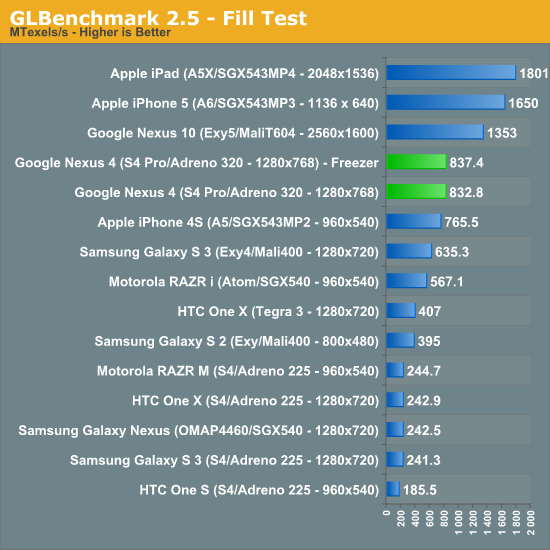
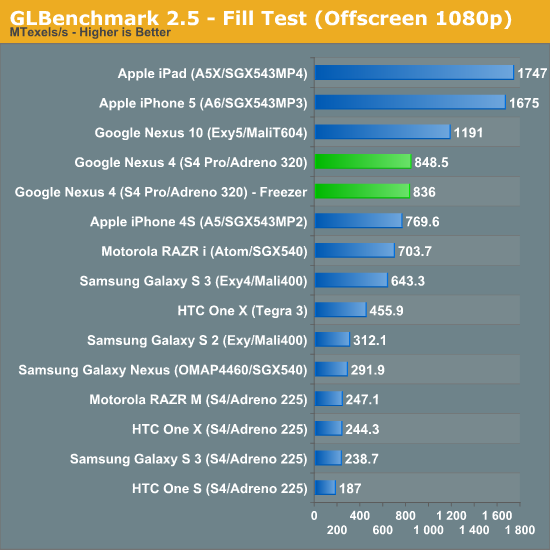
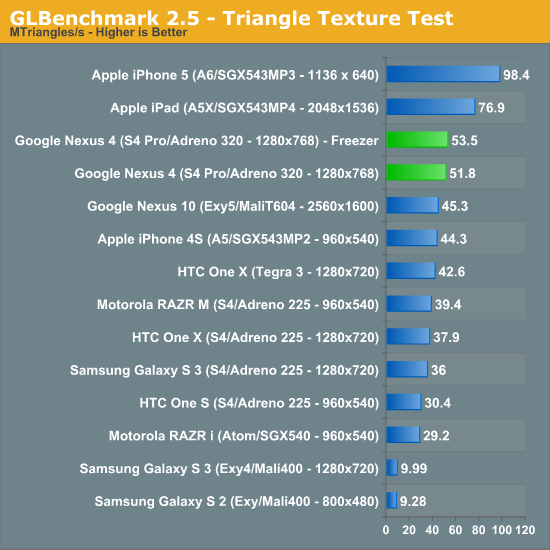
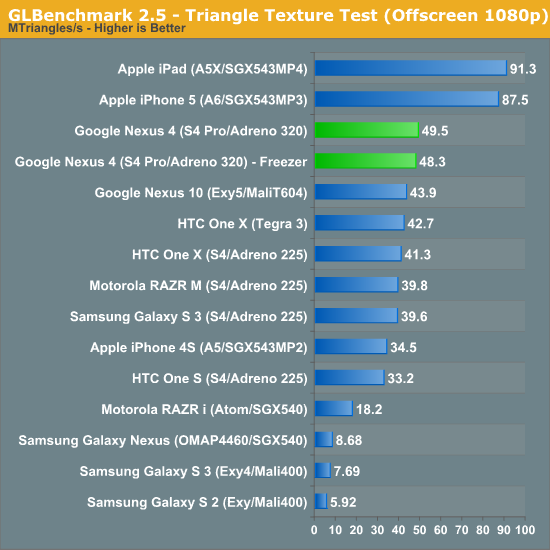
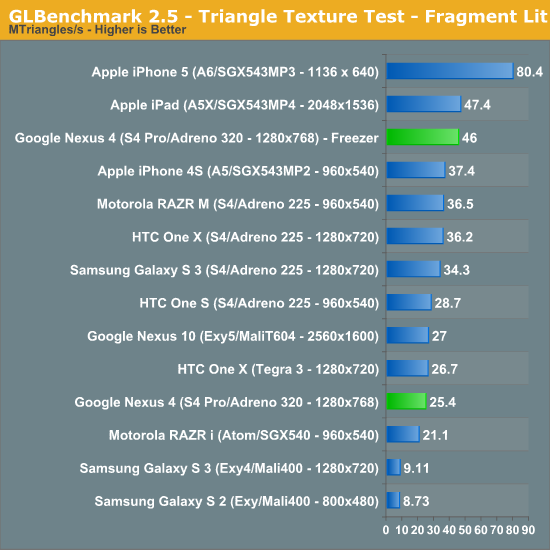
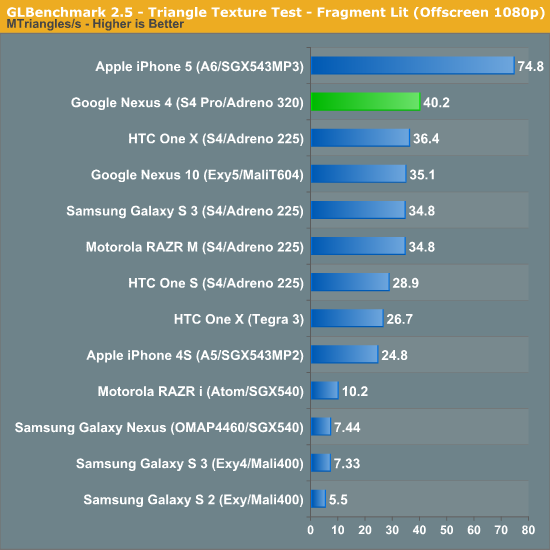
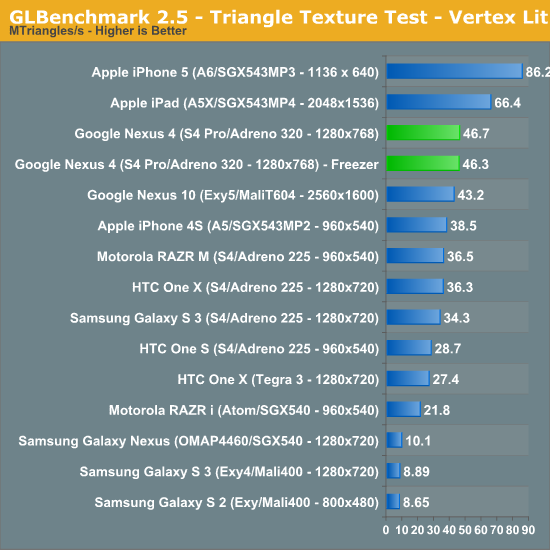
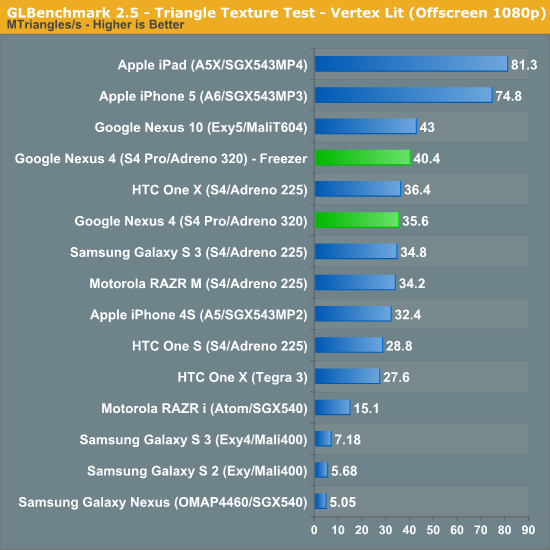
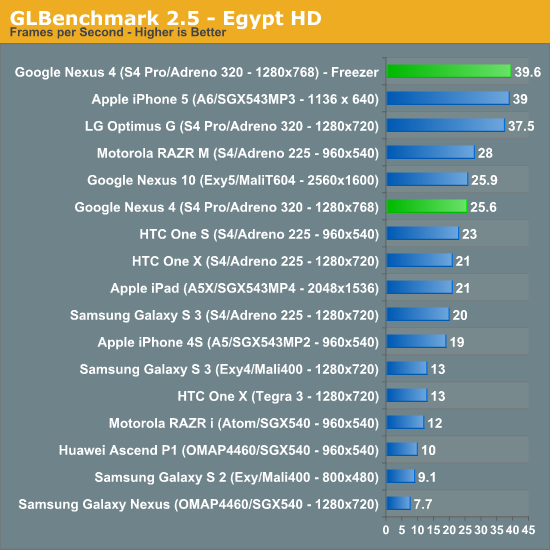
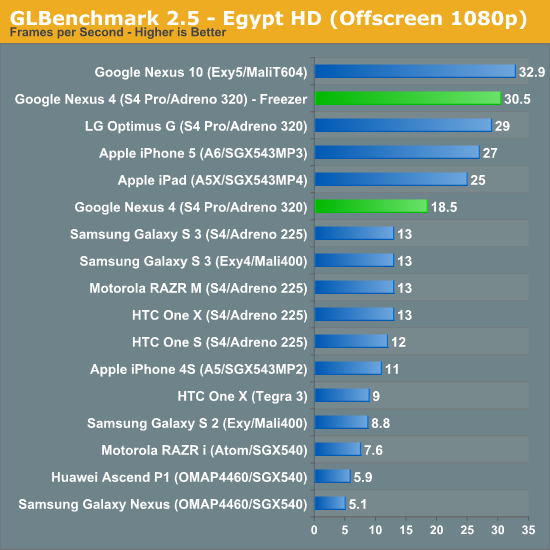
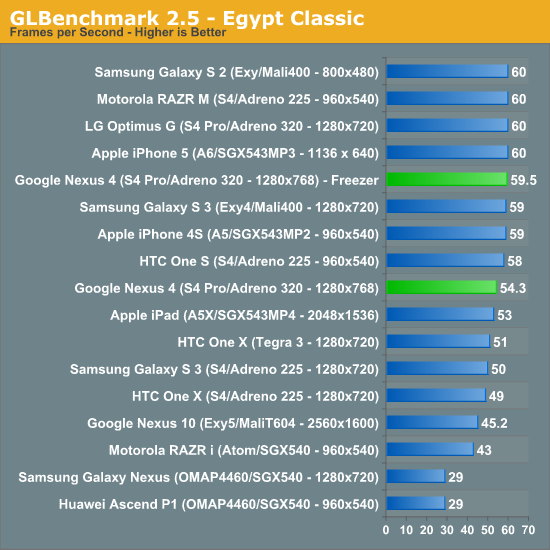
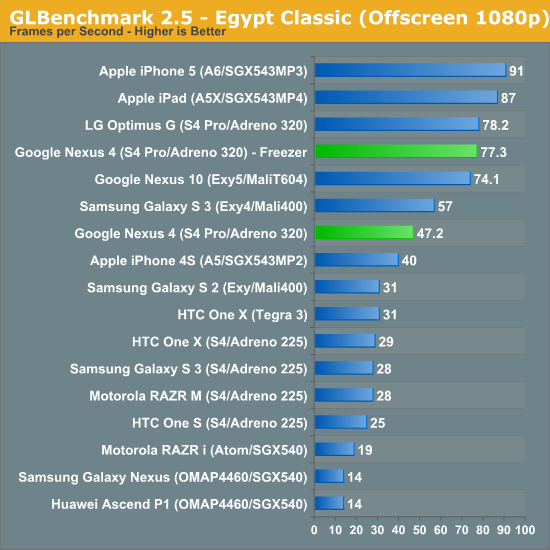
The result of the tests in the freezer results that are much closer to what we'd expect based on the APQ8064 MDP/T runs and the Optimus G numbers I saw in Korea.
When it comes to the CPU side of things there were results also affected by thermal throttling. I spaced some of those runs out (unintentionally) enough that performance didn't change, but for other things it did affect performance. I can't tell what GPU clocks end up being when the SoC decides to throttle, but it is possible to nail down what CPU performance state APQ8064 settles down into when there's throttling going on by looking at the state tables.

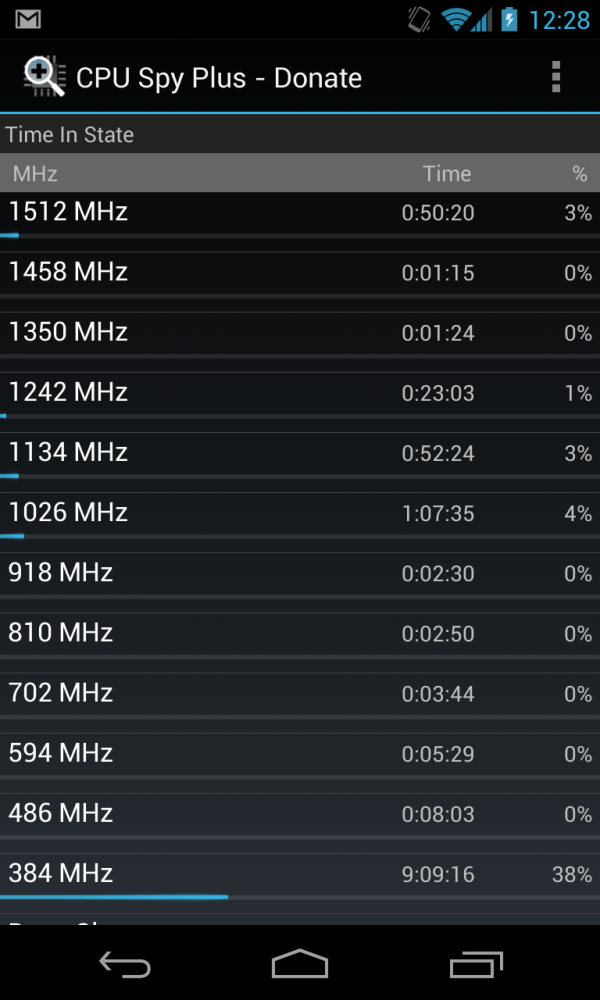
Left - 1.134 GHz during throttling (running tests), Right - All the performance states
I can see the Nexus 4 not use any of the performance states above 1134 MHz when it's getting hot, as shown in the images above. I've tweeted a link to the pastebin for thermald.conf which I believe configures the thermal cutoffs and will be interesting to kernel hackers trying to play with these values.
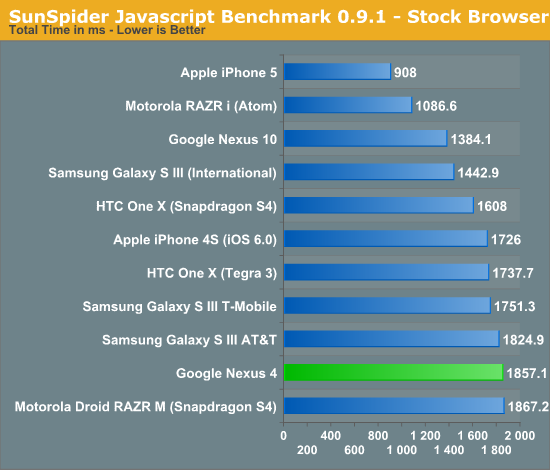
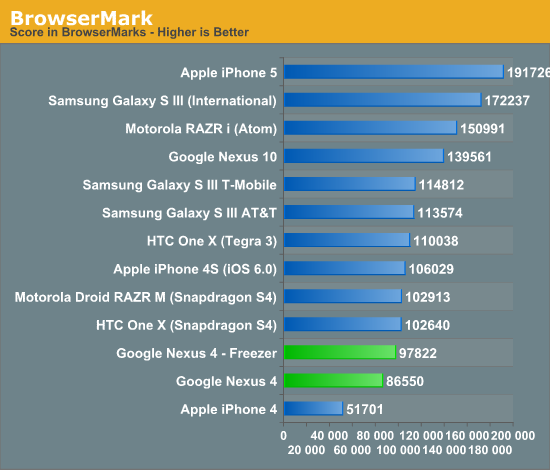
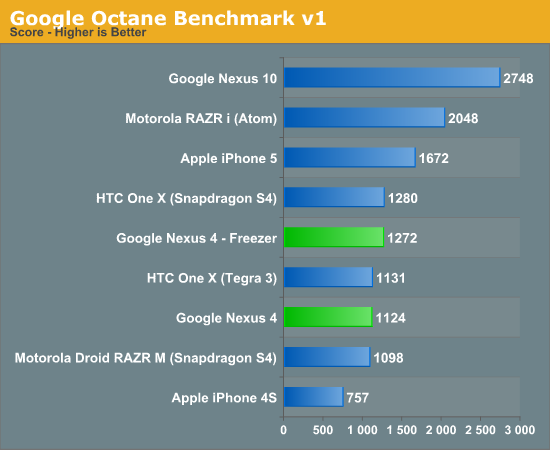
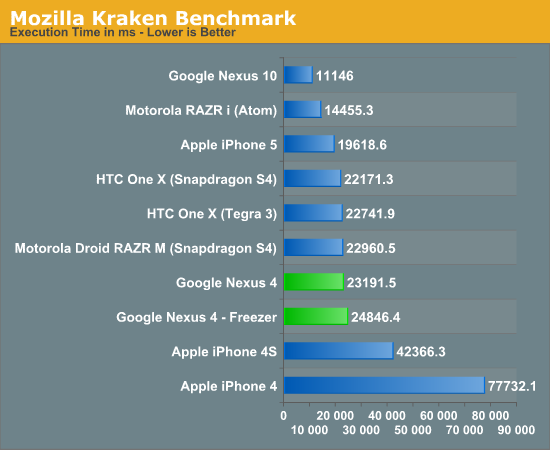
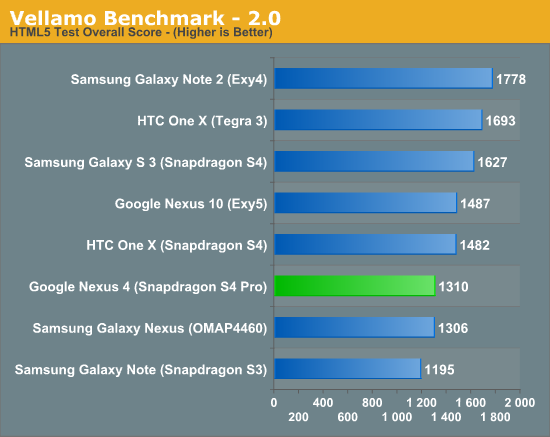
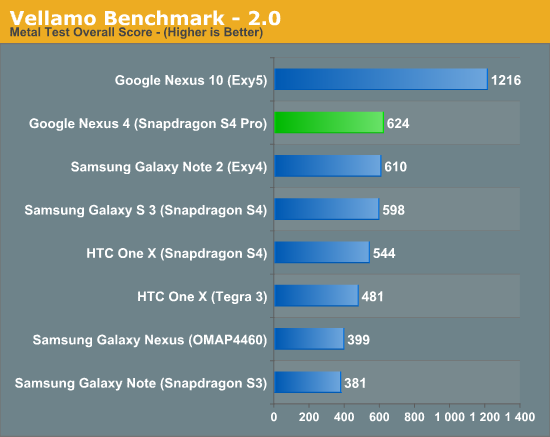
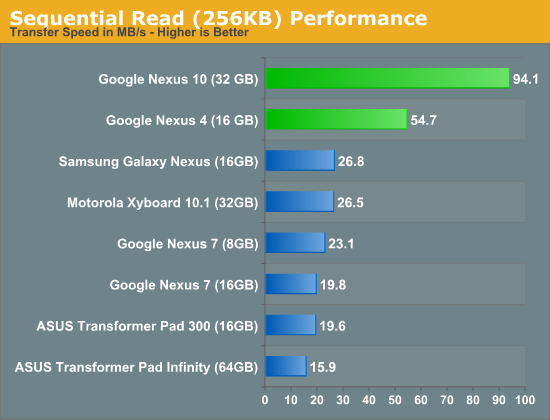
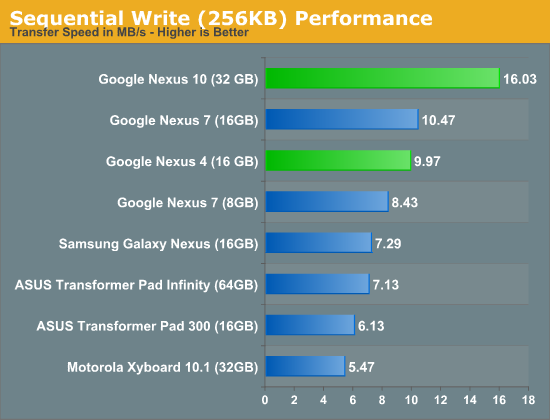
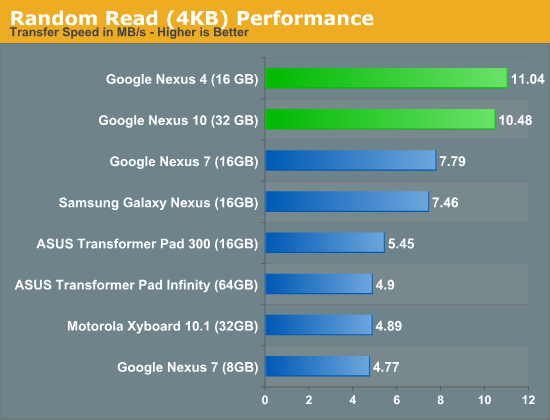
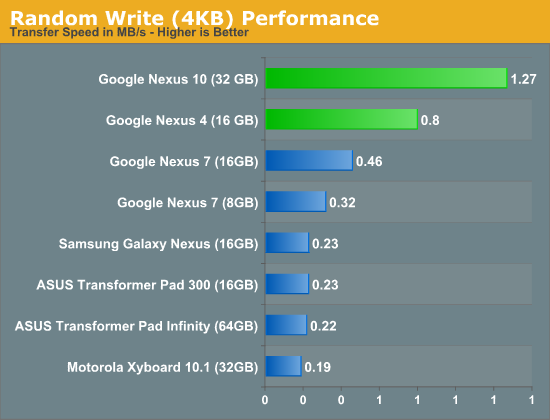
Our CPU performance side is unfortunately still dominated by JavaScript performance tests. The story there is that the Nexus 4 ships with Chrome (and originally shipped with a newer build of Chrome than what was on the market - we were running that updated version all along) and thus the mainline version of the V8 JavaScript engine. OEMs perform their own optimizations to the V8 library, and try to upstream whatever they can into the main project, but in the case of Chrome for Android that means V8 sans secret OEM sauce.










188 Comments
View All Comments
Freedomuser - Wednesday, November 14, 2012 - link
Not so fast. If the tests suite was intense like i think it's then even iphone 5 will get overheated.So, the question is, does any other phones in your chart survived the tests suite? LG Optimus G dropped out. Nexus 4 made it through with overheat. What about others on your chart?
meloz - Thursday, November 15, 2012 - link
>>Not so fast. If the tests suite was intense like i think it's then even iphone 5 will get overheated.But in this test it did not. And in any benchmark in which iphone5 will overheat, the Nexus 4 will overheat and throttl even worse!
I want Android and Nexus to do well, because they represent a more user-friendly (freedom) choice to iphone. But Google seriously need to address overheating, battery life and other such fundamental issues. Nexus 4 is a crappy device, at any price. I hope future software/firmware updates mitigate some of the problems.
piroroadkill - Thursday, November 15, 2012 - link
I don't care if this is the best phone ever, they've made a big mistake by missing out the microSD slot.Mugur - Thursday, November 15, 2012 - link
Just a small mistake in article: "First, audioflinger is set to 48 kHz which results in software resampling causing artifacts for 41.1 kHz source material.". It should be 44.1. not 41.1, I think...Mugur - Thursday, November 15, 2012 - link
Running a 3D game for one hour is one thing, but throttling in a benchmark does not look good.tipoo - Monday, December 24, 2012 - link
Yeah...I wonder if tiny heatsinks in it would solve this, and become a norm as phone SoCs aim for higher and higher performance.cyberguyz - Thursday, November 15, 2012 - link
Seems Google has a problem with allowing the user to expand his storage beyond what they give you. Why is that?The phone comes with 16gb internal flash memory, but no way of expanding it. This seems to be a popular trend with all Google-branded Nexus devices (Galaxy Nexus and Nexus 7 tablet are the same). The lack of sdcard support in an Android device kills the ability to set up a Windows drive letter for it. Without that drive letter many popular programs like Calibre have an issue attaching to the device to manage things like ebooks (this is a real pain in the ass with my nexus 7!!). I for one like the freedom popping in another 64GB microSD card gives me.
The lack of a removable battery also hurts this phone. I have hard experience with the life of li-Ion batteries losing capacity over time in laptops. Every couple years I have to get new batteries because the Li-Ion battery loses capacity until it cant keep my laptop alive for more than 20 minutes without dying. I like Samsungs because I can always replace the battery cheaply when it goes south and I don't have to send my phone (and private data) away for servicing to do it.
Beyond these two (as I consider them major) gripes, this is a really nice phone.
funky247 - Thursday, November 15, 2012 - link
With regard to the non-removable battery issue, most of the people I know don't like non-removable batteries because it limits their ability to whip out a backup battery when they need the extra juice while they're no the go.However, if the issue is with replacing the battery as it gets older, you can do it yourself! It even tells you how to do it in the review. You can buy authentic OEM batteries off of Ebay and do everything yourself, with the right tools. Some sellers will even ship the tools!
cyberguyz - Monday, November 19, 2012 - link
There are both of those issues with non-removable batteries.While the article tells you how to change the battery yourself, they do not mention that if you do that, you void your warranty (granted the warranty is gone after the battery goes south anyway). There are a lot of folks that cringe at the though of splitting open their $500-600 US phone to replace a battery.
I for one don't keep a #4 torx screwdriver around.
The ability to whip in a new battery in 2 sec without special tools in a vendor-blessed manner is a bit plus to me.
Now if only Samsung (or anyone else - I'm not a brand fanboy) would put out an Android-based phone with quad-core Krait or A15, 2GB memory, 32GB expandable storage and user-replaceable battery, I would ebay my SG3 in a heatbeat and be all over it.
Brandy123 - Thursday, November 15, 2012 - link
What I don't get is although the price and specs are very attractive for an unlocked: no contract phone, 8 or 16GB is really small by today's standards when there is no microSD slot! Google is obviously assuming you will be connected to the net 24/7 and streaming your music and videos via Google Play and other services. But then your data usage goes through the roof! Will this aggressive pricing force more carriers to offer truly unlimited data plans and more reasonable prices?Also, HPSA+ is fast enough for most, but lack of LTE is another compromise to get that good price. Yet it still is "the buzz" (note that the sellout time means nothing without knowing the number of units sold.)
So maybe the other key to the popularity of this device may be that with the younger generation, their phone is sort of a status symbol to them. Who can wait 2-years for contract renewal to get a new phone? But who can afford a $900 iPhone with no contract? BAM - Nexus 4 - I can get the latest gadget with specs good enough to brag about, with no contract, and without having to eat Top Ramen for a month to afford it. Who cares it doesn't have enough memory to store my video, photos and MP3 collection. I'll put it all on the Cloud and run my data usage through the roof instead.